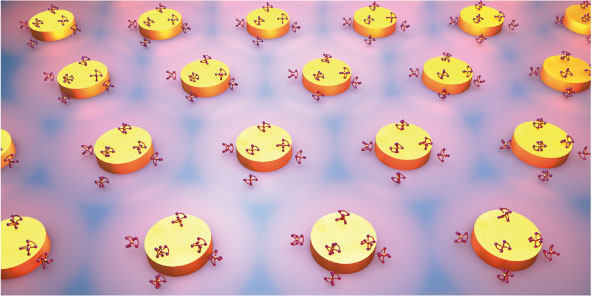Electrogenerated chemiluminescence
Electrogenerated chemiluminescence (ECL) microscopy is a promising technique for monitoring chemical activity in individual nanoparticles. This technique is based on the emission of light by molecular complexes excited by electrical signals. Because it does not require optical excitation, ECL microscopy provides signals with very little background noise compared to Raman and fluorescence microscopy. Furthermore, the used molecular complexes are regenerated after emission, eliminating problems caused by photobleaching.
However, one of the current limitations of ECL microscopy is the low spatial resolution of this technique. So far, ECL microscopy has only demonstrated submicron spatial resolution due to the low quantum yield and diffusive nature of the molecular complexes used. This spatial resolution is far from other techniques such as fluorescence microscopy. Improving the spatial resolution of ECL microscopy requires increasing its intensity, which has been the objective of this work.
One way to improve the intensity of ECL is the coupling of the molecular complexes that generate it with gold nanoparticles. It has been shown that the interaction of the emission of these complexes with the coherent oscillations of the conduction electrons of the gold nanoparticles, commonly known as localized plasmon resonances (LSPRs), can increase or inhibit ECL emission. Previous studies have revealed that, at short distances (1-5 nm), the emission is reduced due to the non-radiative transfer of energy to the nanoparticle. At greater distances (5−20 nm), the emission increases thanks to the modulation of the local density of the optical states produced by the LSPRs.
In this context, the use of periodic nanoparticle matrices can open a new way to improve the intensity of ECL. These systems have unique spectral characteristics that arise from the coherent superposition of the individual response of the nanoparticles that compose them. In particular, when the coupling between the nanoparticles of the matrix is large enough to establish long-range interactions between them, these systems are able to withstand much stronger network resonances than the LSPRs of their constituents.
This article studies the improvement of the intensity of ECL emitted by ruthenium complexes through the optimization of periodic matrices of metallic nanostructures. For this, an optical characterization of different matrices was carried out using three different excitation and measurement geometries. These experiments were complemented with theoretical simulations of the ECL emission based on rigorous solutions of Maxwell's equations, obtained using a finite element method.
It was shown that the increase in the ECL intensity emitted by the ruthenium complexes strongly depends on the geometry of the periodic matrix, as well as on its dielectric environment. By adjusting these parameters, it was achieved that the periodic matrix increased the intensity of ECL emitted by the complexes 23 times. The results of this work lay the foundations for the design of substrates capable of improving ECL intensity based on periodic systems of nanostructures.
Link to the article
The article is a collaboration between the Institute of Optics, the Department of Chemistry, the Department of Electrical and Computer Engineering, and the Department of Chemical and Biomolecular Engineering at Rice University in Houston, the Department of Chemistry at the Faculty of Science at Hokkaido University and the Department of Physics and
Astronomy from the University of New Mexico.







